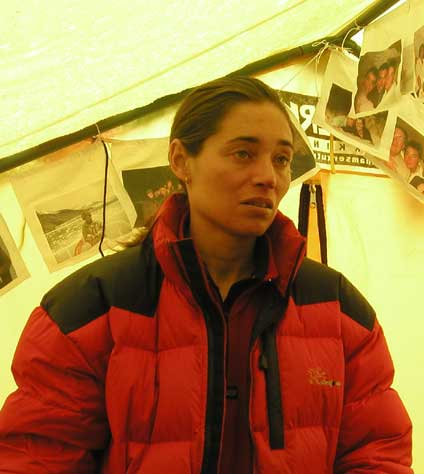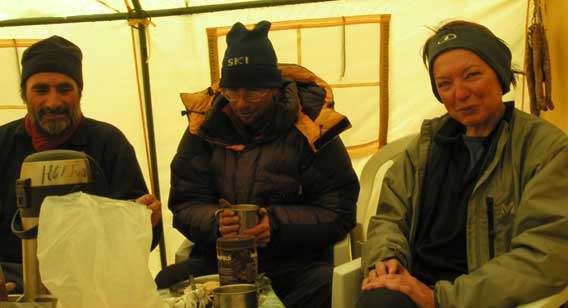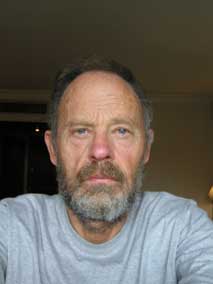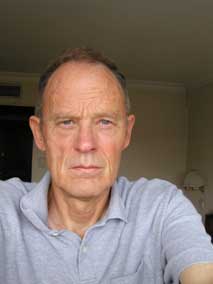Camp 2 to sea level, 19.05.2004 - 28.05.2004.
19.05.2004. Camp 2 to ABC, 7650m->6400m/25100ft->21000ft
Left camp 2 at 8am. Felt weary descending the rock to the top of the snow at 7500m.While I was putting my crampons on, a Sherpa asked me whether I'd
reached the top.
"No, only 8500m, too old."
"How old?"
"Sixty-one."
"Ah, the same age as my grandfather."
Continued down the snow, and met Kancha going up to retrieve the tent and gear from Camp 2. Mostly I cramponed down the hard snow without clipping into the fixed rope.
It was sunny and windless, and I became very hot in my down suit, so I stopped for a brief rest, and unzipped the top half. Just before Camp 1, I passed a Japanese group heading up already using oxygen.
I reached Camp 1 and rested in our tent. Hugues arrived also from Camp 2 while I was there. He said that Ang Babu had complained all the way to summit about having to climb without fixed ropes. Near the top, Ang Babu had left him, and when Hugues arrived on top Ang Babu had on a lama's robe and was praying to some artifacts that he had placed on the summit. On the descent, Ang Babu again left him, and Hugues ran out of oxygen. With no oxygen at 8800m he was barely able to move. He waved to Ang Babu to return, but Ang Babu simply waved back and continued down. Eventually, Ang Babu did wait, and Hugues was able to reach him and get a new oxygen bottle. It was after 8pm when he made it back to Camp 3. He had spent the night there, and descended to Camp 2 yesterday.
About 1pm, Hugues and I set off down the fixed ropes to ABC. On the way down we spoke to two Bulgarian climbers heading up for their tragic summit attempt.
It was a relief to reach ABC and be at an altitude where I could live and eat comfortably.
There was great excitement in our camp when I arrived. Maite and Nuria had
reached the summit a few hours earlier, and had radioed down their success. They
were the first Catalan women to have climbed Chomolungma, and Sylvia was doing live
interviews with Catalonian TV and radio stations via her satellite phone.
[New Zealanders have been climbing Chomolungma with such frequency and for
so long (51 years!) that no one there pays attention any more.]
Later David came down. He had planned to rest and then return for an attempt on the summit using oxygen, but on reaching Camp 1 he discovered that his hands had been frostbitten when his tent blew down in the night at Camp 3. Fortunately, his fingers looked as though they would probably recover without additional permanent damage.
Our neighbours, the Greeks, were down. Five members of the party on the south
side of Chomolungma had reached the summit as had three of eight on the north.
Now they were famous in Greece (well, at least for a few weeks until their
soccer team won the European cup).
[One of those reaching the top had suffered damage to his eyes from both the
cold and the sun, and was almost blind by the time he got back to ABC. Two of
the Greeks escorted him down to base camp, and he was sent back to Kathmandu for
treatment.]
Except for meals, I slept solidly for 36 hours.
20.05.2004. Rest.
It was snowing in the morning. At lunch I learned that Maite and Nuria had been in trouble descending from Camp 3 in bad conditions, and had had to radio for help.Maryse arrived down during the morning --- after her attempt on the 17th, she had spent the night in every camp on the way down.
While we were still having dinner, an exhausted Maite wearing an oxygen mask was helped into the dining tent by two of the Greeks. Sylvia, who is a doctor, helped her (IV tubes etc.), and then she was assisted to her tent.
Shortly afterwards Nuria came in, looking surprisingly fresh and told us their story. On the climb above Camp 3, she (Nuria) had fallen, and thought she would die, but after about 10 metres, an old rope that she had clipped into had held her. They had reached the summit quite early, but soon after beginning the descent they found the two Koreans who had been trapped there the day before. They were still alive, and Maite and Nuria had spent some time with them trying to persuade them to descend, but without success. When it began to snow, they had had to leave them. [A little later, one of the Koreans gave an Indian climber his mother's telephone number and a message for her.]
When they got back to Camp 3, Maite and Nuria were very tired, so they decided to spend the night there in the hope that they would feel better in the morning after a rest and hot drinks. Their Sherpas went down to Camp 1. In the morning Maite and Nuria were just as tired, and it had snowed heavily during the night, but they had no choice except to descend. They had trouble finding the fixed ropes under the snow, but had managed to reach the highest tent (7900m/25900ft) on the north ridge, which to their disappointment was empty. By now Maite was too exhausted to continue, and so Nuria had radioed for help. Three Italians had responded by carrying oxygen and hot drinks up to them from their tents in Camp 2 (c7700m/25260ft). A combination of climbers and Sherpas then succeeded in rescuing them.
Nuria was upset that, while so many people had combined to successfully rescue them, they had been unable help the Koreans.
21.05.2004, ABC -> base camp


In the morning Maite (left) had recovered; on the right, Nuria.

Hugues, David, and Maryse. David's fingers are already starting to turn black.
Pemba had ordered the yaks for the 23rd. They would carry everything down to base camp on the 24th, and our gear would reach Kathmandu on the 26th . We (H+M+D+me) decided we would walk down today and hope we could persuade the TMA to allow us to leave for Kathmandu on the 22nd.
I packed up, said goodbye to everyone, and left at 10am. The weather was gloomy during the descent (light snow), but I reached base camp at 4:30pm. Hugues and Maryse arrived at about 6, but David not until after dark at 9pm.
22.05.2004, Bored at base camp
Our efforts to persuade the TMA to arrange for us to leave early were unsuccessful --- they claimed that there were no jeeps available. [However, when we got down to Dingri on the 24th, there were a dozen idle jeeps --- I'm sure that if we'd offered to pay extra, a jeep would have miraculously become available.]At lunch a Nepalese woman was bragging about how many times she had climbed Chomolungma while David whispered in my ear that he thought she was the person who had been so slow on the second step of the northeast ridge last year that 20 climbers behind her had been forced to abandon their attempt on the summit.
Once when I was trying to explain, without much success, to some do-or-diers why I had done neither, David commented (perceptively) that I was a mountaineer.
23.05.2004, Bored at base camp.
The Spanish arrived down from ABC --- their sponsors are arriving, and they are to entertain them.News.
An Italian who had been missing was found to be at Camp 3, where he had
spent 3 nights --- he was so badly frostbitten that he may lose all his fingers.
A Mexican had reached the summit without oxygen, but then had to be rescued
on the descent.
A Greenlander, hoping to be the first from his island to climb Chomolungma,
was unsuccessful, but planned to return next year with three others.
A rumour that three more climbers had died on the northeast ridge happily turned out to be false.
24.05.2004, to Dingri
Finally, about 4pm, our jeeps arrived, and we drove to Tingri.[Today was very windy, and a Sherpa took advantage of the absence of other climbers to claim the fastest ascent of Chomolungma (from the south). The previous record holder said he didn't believe him, but none of the Sherpas seemed to believe him either.]
25.05.2004, to Kathmandu
Left at 7am, and reached Kathmandu at 6:30pm26.05.2004. Kathmandu.
Succeeded in changing my tickets so I now depart on the 28th, and get home on the 29th.

I visit a barber.
27.05.2004. Kathmandu.
Our Sherpas and gear arrived in Kathmandu late yesterday, so I went out to Thamserku and arranged it with the help of Pemba. I sold all my oxygen gear back to Thamserku, so no more attempts on 8000ers: Cho Oyu didn't look so exciting from 8500m on Chomolungma, the southern route on Chomolungma holds no interest for me, and clearly I lack the correct do-or-die (Mallory-Irvine) spirit for the northern route.While I was talking to Mr Rai, the Greeks were having a row with their Sherpas: it is standard that Sherpas are paid a bonus of $700 for reaching the summit, but the Greeks were refusing to pay.
28.05.2004. To Bangkok, 0m/0ft
29.05.2004. To Ann Arbor, 255m/837ft.
Postscript: On May 28, 2004, Sherpas acting on the instructions of Russell Brice cut down all the fixed ropes below the North Col (Camp 1), including those place there by other teams, while climbers were still attempting the summit. Tired climbers require these ropes to be able to descend safely --- for example, there is an almost vertical ice cliff that would be difficult to descend with neither a rope nor specialized ice climbing equipment. Fortunately, another group was able to replace the ropes on the more difficult sections.
Postscript 23.05.2006. David Sharp attempted Everest again from the north in 2006, and died there. It appears that he ran out of oxygen while descending, probably from the summit. At least 40 climbers saw him in difficulties the next morning about 300 metres above Camp 3 as they headed for the summit, but by the time one of Russell Brice's sherpas offered him oxygen it was apparently too late. He was 34 years old and the sixth climber to die on Everest in 2006.
Postscript 24.05.2006. Ed Hillary said he was shocked at the dozens of climbers,
in particular, those in the group including New Zealander Mark Inglis, who
continued with their ascents without offering any serious assistance to David
Sharp. "It was wrong if there was a man suffering altitude problems and was
huddled under a rock, just to lift your hat, say 'good morning' and pass on by.
... I don't think it matters a damn whether it's a member of another party - if
he'd been a Swiss or from Timbuktu or whatever - that didn't matter, he was a
human being and we would regard it as our duty to get him back to safety... I
don't approve of the fact he just rang up base camp and let them know about the
guy out there ... that attitude to me is pathetic"
In response, Inglis said that he had radioed his
base camp and been told: "Look, you can't do anything. He's been there X number
of hours, without oxygen. He's effectively dead". His expedition leader, Russell
Brice, had made the decision to leave him. Later Inglis said that David was
virtually frozen solid, could not speak and the only signs of life they could
detect was movement in his eyes. [Other climbers give a different picture ---
some report that David was still alive and lucid when they saw him on their descent
many hours later. The reports of David's condition in radio conversations overheard
by other climbers on the day differ from those given later. Until
David had been helped with oxygen and drinks for a considerable time, no one could say
with any certainty whether it was possible to save him.]
In response, Brice said that "at no stage during
the ascent did I know that there was a man in trouble... There were never any
radio conversations concerning the sighting of David Sharp between my team
members and myself during the ascent."
According to another New Zealander, Jamie
McGuinness, who climbed with David on Everest in 2003, "Dawa [Sherpa] from Arun Treks
also gave oxygen to David and tried to help him move, repeatedly, for perhaps an
hour. But he could not get David to stand alone or even stand resting on his
shoulders, and crying, Dawa had to leave him too. Even with two Sherpas it was
not going to be possible to get David down the tricky sections below. Dawa, who
did not summit because of giving his oxygen to David, told this to me less than
24 hours later when I met him on the fixed ropes. He was close to tears even
then." Source [Obviously, it was
too much to expect of one Sherpa, but with a more prolonged effort, two may have succeeded. Since
David had twice climbed to 8500m without oxygen, I would expect him to be able to survive
a night at that altitude and be able to descend with help.]
Eleven climbers died on Everest in the spring of 2006. Oops, make that
ten --- the eleventh, Lincoln Hall, was found still alive at 8600m by an expedition led by Dan Mazur,
which gave up its summit attempt in order to rescue him. According to his agent, Hall will
make several hundred thousand dollars selling his story.
The most complete accounts of the events
surrounding David's death that I've found are at:
everestnews.com and
mounteverest.net
Postscript 18.04.2015. Hugues d'Aubarede was killed in a fall during the descent of K2 on 2 August 2008.
For me, it's not beating the conditions but being with the conditions. It's knowing when the mountain is letting me go up and knowing when it's telling me to go down. That's the art. You have to know when to listen.
Ed Viesturs, only the twelfth person to climb all fourteen 8000m peaks (New York Times, June 18, 2005).
[I worry most] when he approaches the summit. I know he's careful but also know that stuff happens up there.
Ed Viesturs's wife (ib.).
The next thing an aspiring mountain climber should do is choose which mountain to climb. Mountain climbers that are still alive (usually because of luck and not for long) will probably advise that you should start with a fairly easy mountain to ascend so that you aren't killed or maimed or disfigured. However, that is total nonsense since as a mountain climber it is inevitable that you will be killed, maimed, and disfigured, possibly in that order. So, if you want to climb Mt. Everest first, go for it and God have mercy on your soul.
From: How to Climb Mountains